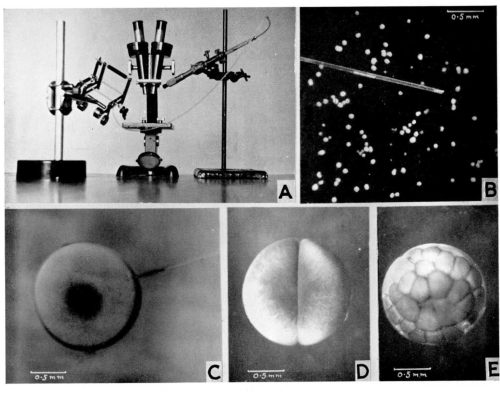First issues – tick tock heat shock
Posted by Alex Eve, on 14 February 2025
As part of our ‘first issues’ series on the Node, Development’s in-house team are researching the authors of articles published in the first issues of Journal of Embryology and Experimental Morphology (JEEM) and its reincarnation, Development.
Take a look at the other articles featured in the series:
• Publishing developmental biology through the decades
• Culture most fowl by Katherine Brown
• Breaking newt by Laura Hankins
• Audrey across the Atlantic by Joyce Yu
In this final post, we meet Tom R. Elsdale, a former embryologist at the Medical Research Council Human Genetics Unit in Edinburgh, UK, (Fig. 1) and an author in the first issue of Development, with an interest in understanding one of life’s big philosophical questions: time.
Born in 1929 in Somerset, UK, Tom Elsdale was raised by opera singer Vivian (née Miller) Elsdale and World War I marksman Henry Elsdale. Unusually, his dad also had a second home and family, fathering many children – one of whom accidentally blinded Elsdale in one eye by shooting him with an arrow (Bard, 2014). Despite this unorthodox upbringing, Elsdale would go on to be a remarkable developmental biologist and have fantastic taste in jumpers (Fig. 1).

Following his undergraduate degree at the University of Reading, UK, Elsdale undertook his PhD studies with the renowned Conrad Waddington (Bard, 2014), a founding Editorial Board member of JEEM and likely one of its early supporters who pitched the journal to The Company of Biologists (Eve, 2025). Waddington published in the second-ever issue of the journal (Waddington and Carter, 1953) and several times thereafter, although Waddington and Elsdale never did publish together.
As a postdoc at the University of Oxford, UK, with Russian-born biologist Michail “Michael” Fischberg, Elsdale taught John Gurdon how to perform nuclear transfers in Xenopus laevis, following in the footsteps of Audrey Muggleton-Harris‘s work on amoebae. They adapted their approach from Briggs and King (1952), which involved taking nuclei from embryonic cells and transferring them into enucleated eggs, successfully cloning animals that survived into adulthood (Gurdon et al., 1958). Their technique was later published in JEEM (Elsdale et al. 1960), and you can watch Elsdale performing it as part of the Node’s ‘show and tell’ series (see Fig. 1, 2). Gurdon would use this approach to publish an article in 1962, also in JEEM, where he demonstrated that nuclei from differentiated cells (epithelia) could give rise to new embryos, successfully cloning an adult frog (Gurdon, 1962). It was for this work that Gurdon was awarded the 2012 Nobel Prize for Physiology or Medicine (Gurdon, 2013a,b), together with Shinya Yamanaka and his discovery of reprogramming cells to produce induced pluripotent stem cells (Takahashi and Yamanaka, 2006). Before being awarded the Nobel Prize, Gurdon also served as the Chair of the Board of Directors for The Company of Biologists from 2001 to 2011, demonstrating another indirect link Elsdale had with the Company (Bray et al., 2025).

Following his work on cloning amphibians, Elsdale started his own lab in the seemingly close-knit community at the Institute of Animal Genetics (IAG) in Edinburgh, UK, where he was colleagues with Ruth Clayton, and links him to The Company of Biologists yet again via the IAG’s founder, Francis Crew (Hankins and Rutledge, 2023; Knight, 2023). Elsdale became interested in optimising in vitro biology, demonstrating that frog embryonic cells could be cultured as aggregates. These studies revealed insights about gastrulation, germ layer formation and differentiation (Jones and Elsdale, 1963). One might also argue that these were prototype ‘xenobots’ – as published 60 years later to much media fanfare (Kriegman et al., 2020). Like the Wolffs, Elsdale was also a pioneer for culture conditions, using collagen rather than glass or plastic to aid fibroblast cell maintenance well before the days of Matrigel™ (Elsdale and Bard, 1972).
By the point of the latter study, Elsdale had moved from the IAG to the MRC Clinical & Population Cytogenetics Unit in Edinburgh, UK, where he then published a series of papers addressing somitogenesis. Returning – once again – to frogs, Elsdale and colleagues frequently used heat shock, which was known to cause developmental phenotypes in rats (Škreb and Frank, 1963), as a method of understanding more about developmental timing and robustness in morphogenesis (Elsdale et al., 1976; Pearson and Elsdale, 1979a,b; Cook and Elsdale, 1980; Elsdale and Davidson, 1983). Elsdale’s first paper on somitogenesis followed the landmark ‘clock and wavefront’ model of segmentation by Cooke and Zeeman, published the previous year, which became textbook in the field (Cooke and Zeeman, 1976). Today, although the model has not been immune from scrutiny (e.g. Murray et al., 2011; Klepstad and Marcon, 2024), it has formed the basis for many significant studies revealing the molecular mechanisms behind somitogenesis in vivo and, more recently, in vitro systems that undergo segmentation-like processes (reviewed in Miao and Pourquié, 2024). Collectively, these studies on the segmentation clock are a wonderful illustration of one form of timekeeping in development.
Before retiring in Spain, Elsdale published his final paper in the first issue of Development, ‘Timekeeping by frog embryos, in normal development and after heat shock’, in which Elsdale and Duncan Davidson explore how a population of embryos within a species develop at the same rate (Elsdale and Davidson, 1987). If you’ve ever seen a clutch of frog eggs developing, such as the Xenopus embryos undergoing cleavage in the video below (Fig. 3), you’ll appreciate that the synchrony between the individuals is extraordinary.
In their paper, Elsdale and Davidson collected Rana temporaria spawn from a local pond and incubated the embryos at 15°C. By recording the development of three spawns from different locations, they report relatively little variation in developmental rate. Next, they use Elsdale’s favourite manipulation (heat shock by limited exposure to 37°C) to perturb the embryos, being careful to ensure that the extent of the heat shock does not induce developmental phenotypes that occlude accurate embryo staging through counting somites. They reveal that heat shock delays embryonic development, with longer exposures to high temperatures increasing the delay, roughly equivalent to one hour of delayed growth per minute of heat shock. Interestingly, though, the embryos go through a ‘rest and recover’ process: embryos stop developing during the heat shock during a ‘rest phase’ and then continue development at the same rate as controls. In other words, the delay in development caused by heat shock is not due to an overall slowing of the pace of embryogenesis, nor do embryos speed up following heat shock to recover lost time. Elsdale and Davidson speculate that some exceptionally stable ‘relaxation oscillator’ could account for this ‘rest phase’, resulting from the degradation of a factor during heat shock that must be replenished before development can continue; they propose that DNA might be the factor involved. Finally, they pursue an earlier observation that short exposure to heat shock-inducing temperatures protects against subsequent shocks (Pearson and Elsdale, 1979a). They show that embryos exposed to two shocks of 8 minutes each, given two days apart, have less developmental delay than embryos exposed to a single 16-minute shock. In the former condition, embryos have a shorter rest phase.
I think this is a really interesting paper that raises many questions relevant to modern research but, with only six citations, it seems to have largely gone unnoticed. Understanding how embryos ensure a steady developmental pace, perceive and interpret time for the synchronous development of organs and tissues, and modify regulatory mechanisms for heterochronic development in or between species is pertinent today. The field of developmental time has grown in recent years with regular meetings on the topic and is a flourishing area of research, both conceptually and experimentally (e.g. Garcia-Ojalvo and Bulut-Karslioglu, 2023; Ebisuya et al., 2024). The heat shock pathway Elsdale used to induce developmental phenotypes was later coopted for inducible transgenic expression systems in several models, including Xenopus (Wheeler et al., 2000), and temperature-sensitive manipulations remain important tools for studying development that continue to be developed (e.g. Benman et al., 2025). Similarly, the relationship between temperature and development is as relevant now as 40 years ago, particularly in the context of climate change (e.g. Moriyama et al., 2023; Kale et al., 2023, preprint). I think it’s safe to say that, in many ways, Tom Elsdale was ahead of his time.
And thus, this post concludes our ‘first issues’ series in honour of The Company of Biologists’ 100-year anniversary. We hope you’ve enjoyed another look at JEEM/Development’s archives, and maybe we’ve inspired you to take a look yourselves. If you find a hidden treasure, why not tell the community about it here on the Node?
References
Bard, J. (2014). Tom Elsdale obituary. [online] the Guardian. Available at: https://www.theguardian.com/science/2014/jul/18/tom-elsdale-obituary [Accessed 10 Jan. 2025]
Benman, W., Huang, Z., Iyengar, P., Wilde, D., Mumford, T. R. and Bugaj, L. J. (2025). A temperature-inducible protein module for control of mammalian cell fate. Nat Methods. https://doi.org/10.1038/s41592-024-02572-4
Bray, S. J., Royle, S. J., Shiels, H. A. and St Johnston, D. (2025). The Company of Biologists: celebrating 100 years. Development; 152 (1): dev204567. doi: https://doi.org/10.1242/dev.204567
Briggs, R. and King T. J. (1952). Transplantation of living nuclei from blastula cells into enucleated frogs’ eggs * Proc Natl. Acad Sci USA; 38 (5) 455-463, https://doi.org/10.1073/pnas.38.5.455
Ebisuya, M., Rayon, T., Diaz-Cuadros, M., Chalut, K. J., Wu, G., Dodd, A. N., Torres-Padilla, M. E., Levine, M. and Gladyshev, V. N. (2024). Understanding how cells and organisms keep time during development. Dev Cell; 59(13):1623-1627. doi: 10.1016/j.devcel.2024.05.029
Elsdale, T. R., Gurdon, J. B. and Fischberg, M. (1960). A Description of the Technique for Nuclear Transplantation in Xenopus laevis. Development; 8 (4): 437–444. doi: https://doi.org/10.1242/dev.8.4.437
Elsdale, T. and Davidson, D. (1987). Timekeeping by frog embryos, in normal development and after heat shock. Development; 99 (1): 41–49. doi: https://doi.org/10.1242/dev.99.1.41
Eve, A. (2025). Development: a journal’s journey. Development; 152 (3): dev204602. doi: https://doi.org/10.1242/dev.204602
Garcia-Ojalvo, J. and Bulut-Karslioglu, A. (2023). On time: developmental timing within and across species. Development; 150 (14): dev201045. doi: https://doi.org/10.1242/dev.201045
Gurdon, J., Elsdale, T. and Fischberg, M. (1958). Sexually Mature Individuals of Xenopus laevis from the Transplantation of Single Somatic Nuclei. Nature; 182, 64–65. https://doi.org/10.1038/182064a0
Gurdon, J. B. (1962). The Developmental Capacity of Nuclei taken from Intestinal Epithelium Cells of Feeding Tadpoles. Development; 10 (4): 622–640. doi: https://doi.org/10.1242/dev.10.4.622
Gurdon, J. B. (2013a). The cloning of a frog. Development; 140 (12): 2446–2448. doi: https://doi.org/10.1242/dev.097899
Gurdon, J. B. (2013b). The egg and the nucleus: a battle for supremacy. Development; 140 (12): 2449–2456. doi: https://doi.org/10.1242/dev.097170
Hankins, L. E. and Rutledge, C. E. (2023). Class of 1923: looking back at the authors of JEB’s first issue. J Exp Biol; 226 (1): jeb245424. doi: https://doi.org/10.1242/jeb.245424
Jones, K. W. and Elsdale, T. R. (1963). The Culture of Small Aggregates of Amphibian Embryonic Cells in vitro. Development; 11 (1): 135–154. doi: https://doi.org/10.1242/dev.11.1.135
Kale, G., Agarwal, P., Diaz-Larrosa, J. J. and Lemke, S. (2023). Elevated temperature fatally disrupts nuclear divisions in the early Drosophila embryo. bioRxiv; 2023.09.17.558127; doi: https://doi.org/10.1101/2023.09.17.558127
Klepstad, J. and Marcon, L. (2024). The Clock and Wavefront Self-Organizing model recreates the dynamics of mouse somitogenesis in vivo and in vitro. Development; 151 (10): dev202606. doi: https://doi.org/10.1242/dev.202606
Knight, K. (2023). Journey through the history of Journal of Experimental Biology: a timeline. J Exp Biol; 226 (22): jeb246868. doi: https://doi.org/10.1242/jeb.246868
Miao, Y. and Pourquié, O. (2024). Cellular and molecular control of vertebrate somitogenesis. Nat Rev Mol Cell Biol; 25, 517–533. https://doi.org/10.1038/s41580-024-00709-z
Moriyama, D. F., Makri, D., Maalouf, M.-N., Adamova, P., de Moraes, G. F. A., Pinheiro, M. de O., Bernardineli, D. L., Massaia, I. F. D. S., Maalouf, W. E. and Lo Turco, E. G. (2022). The effects of temperature variation treatments on embryonic development: a mouse study. Scientific Reports; 12(1), 2489. https://doi.org/10.1038/s41598-022-06158-y
Murray, P. J., Maini, P. K. and Baker, R. E. (2011). The clock and wavefront model revisited. J Theor Biol; 283(1):227-38. doi: https://doi.org/10.1016/j.jtbi.2011.05.004. Epub 2011 May 27. PMID: 21635902
Škreb, N. and Frank Z. (1963). Developmental Abnormalities in the Rat Induced by Heat Shock. Development; 11 (2): 445–457. doi: https://doi.org/10.1242/dev.11.2.445
Takahashi, K. and Yamanaka, S. (2006). Induction of pluripotent stem cells from mouse embryonic and adult fibroblast cultures by defined factors. Cell; 126(4):663-76. doi: https://doi.org/10.1016/j.cell.2006.07.024
Xenbase. (2025). Xenopus Development Times – Xenbase. Www.xenbase.org, Available at: www.xenbase.org/xenbase/static/anatomy/xenopustimetemp.jsp. [Accessed 21 Jan. 2025]



 (3 votes)
(3 votes)